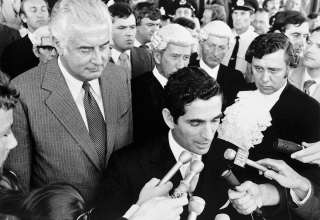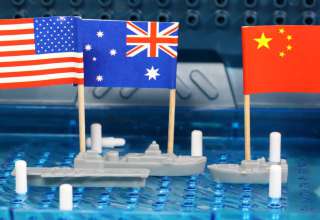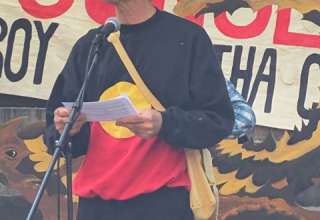by Humphrey McQueen
The China and Taiwan issue has aroused much debate and controversy. In the West, there have been plenty of accusations against China, in particular being undemocratic. However, the West is no clean skin and is itself guilty of deception, double standards, misrepresentation, and interference. Spirit of Eureka asked Humphrey McQueen to provide background information and a timeline surrounding the events of Taiwan’s forced separation from China.
China and foreign devils
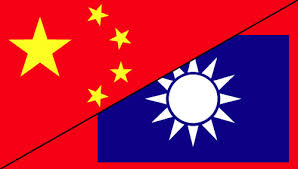 Thirty years ago this May, the Taiwan regime ended its state of war with the Red Bandits ruling on the mainland since 1949. Ever since the Kuo Min Tung (KMT) escaped to Taiwan, the Western media have headlined threats of a Red Horde crossing the Taiwan Strait. How often are we reminded of aggressions in the other direction? Nor do we hear much about the place of Taiwan in 400 years of imperialist aggression towards China.
Thirty years ago this May, the Taiwan regime ended its state of war with the Red Bandits ruling on the mainland since 1949. Ever since the Kuo Min Tung (KMT) escaped to Taiwan, the Western media have headlined threats of a Red Horde crossing the Taiwan Strait. How often are we reminded of aggressions in the other direction? Nor do we hear much about the place of Taiwan in 400 years of imperialist aggression towards China.
One problem with the Chinese is that they dwell on the past. If they want to be part of the modern world they will have to take lessons from Western politicians and corporation executives who are forever ‘moving on,’ ‘putting the past behind us,’ and consigning yesterday’s criminalities to ‘Ancient history.’ Instead of remembering the Opium Wars and the ‘carving up the Chinese melon,’ the Chinese need to become like Australians who never give a second’s thought to Gallipoli or the Burma Railway. To achieve that state of mind, the Chinese should tune into the BIG thinkers on ABC Radio National who are as ignorant about Taiwan as a frog is innocent of feathers.
All ‘news’ is fake when it comes from ‘the context of no context.’ In that context, ‘Frantic’ Kelly will interrupt – yet again – to accuse anyone capable of rubbing two facts together of being of a conspiracy theorist.
Outline:
1500 to 1700s: Not Marco Polo.
1770s to 1860: All the tea in China for all the opium in India.
1860-94: Carving the Chinese Melon:
i. Rising sun, I;
ii. France into Vietnam;
iii. Britain into Tibet.
1894-1901: Kicking the Door Open:
i. Rising Sun II;
ii. Uncle Sam and all …;
1943-1949: Closing the door.
1949-71 Take you pick:
i. Guns across the Strait;
ii. Is there a rhinoceros in the room?
1971-1979: Recognising Red Bandits.
1987-1997: La guerre est fini.
Appendices:
A. De-colonise the oceans!;
B. Cruising the waterfront;
C. How super is Chinese power?
i. technology;
ii. economy.
D. Personal reflections: Everybody’s guess.
1500s to 1700s: Not Marco Polo.
One hangover from the rival European invasions of East Asia in the late 1500s is the West’s uncertainty about what to call the island. Taiwan is the Chinese name. Formosa is the name the Portuguese gave it, meaning ‘blessed isle’because of its fertility. The Portuguese were brushed aside by the Dutch East India Company before its agents were driven out in January 1662 by a force still loyal to the vanquished Ming. In 1683, a Manchu army reclaimed the island as an appendage of the mainland province, Fujian.
1770s to 1840: All the opium in India for all the tea in China.
Imperial China allowed some foreign traders, confining them to toeholds around Canton and Macao while imposing high taxes and lots of paperwork. Anyone who fails to learn the ropes could end with a chord being tightened around his neck.
1788, 18 January. Royal Navy arrives at Botany Bay to establish a refitting station to China in case the Dutch again blockade the Straits of Malacca.
1793. British mission to China, costing the East India Company £80,000, fails to open up trade.
1819. British East India Company sets up Singapore as an alternative to
Batavia as a trading post between India and China. As the exports of tea by the East India Company keep expanding so do its vexations at restriction around Canton. Even worse, the trade is one-sided – shark fins, bird nests and an occasional cargo of Alaskan furs amount to nothing. The British become addicted to pushing opium in order to get back the silver that they are paying for the tea.
1839, July. Britain attacks after the Chinese burn shiploads of opium.
12 August, Britain seizes Hong Kong.
3 November, British sink Chinese junks.
1842, March 15. Britain invades China to enforce sale of opium and bibles.
Engels recalled that a Manchester manufacturer asked him: ‘How can we ever produce too much? We have to clothe 300 million people.’ Or, as Engels puts it, it was as if ‘two thousand million new consumers had been discovered on the moon.’1
1843, 3 April. Victoria Regina declares Hong Kong a Crown Colony. [Popular outrage at China’s humiliation leads to the Taiping Rebellion during which as many as 20 million lose their lives. The chaos allows more barbarians to grab what they can.]
1857-60. Second Opium War.
1858. China forced to authorize the sale of opium.
1860, 13 October. British and French troops occupy Beijing. The British destroy the Summer Palace.
1860s to 1894: ‘Carving the Chinese melon.’
1860, 14 November. China cedes all territory east of the Usuri River to Russia.
1871, 27 November. Taiwanese aborigines kill 54 shipwrecked Ryukyuan sailors.
[The island chain runs from 180km south of Kyushu to 360 km north of Taiwan.]1873, 29 June. The Japanese, Russian, U.S., British, French and Dutch ambassadors present their credentials to the Emperor. They do not have to kowtow.
i. Rising Sun I
[From 1853, the U.S. and other imperialists bombard Japan’s rulers into recognising that, in order to remain independent, they will have to copy their attackers by conquering parts of China and its suzerain states, Korea, the Ryukyu kingdom, etc. To survive, one faction in Japan organises the Meiji Restoration in 1868.]1874, 7 May. More than 3,000 Japanese troops invade Taiwan to punish the aborigines for killing the 54 Rukyuans in 1871.
3 December, Japanese withdraw after burning indigenous villages.
1875, 10 June. Japan announces its dispatch of troops to the Ryukyu Islands.
14 July. Japan forbids the Ryukyuan monarchy to send tribute to China.
27 November. In response to Japanese advances and incursions of Taiwan, the Governor of Fujian is instructed to spend half of each year there and the other half on the mainland.
1876, 16 January. China sets up the prefecture of Taibei (Taiwan).
1879, 8 March. Japan invades the Ryukyu Islands, and occupies the capital Naha.
4 April. Japan turns Ryukyu Islands into its Okinawa Province.
3 July. A Ryukyuan official seeks Chinese help against Japanese invaders.
20 September. The U.S. proposes dividing the Islands between Japan, China and the Ryukyuan kingdom.
1880, 26 March. That tripartite division is negotiated.
ii. France further into Vietnam
1882, 20 December. China withdraws from the port of Tongking in exchange for France’s promise not the threaten Vietnam’s independence.
1883, 16 November. China and France dispute the tributary status of Vietnam.
1884, late June. French and Chinese battle along the border with Vietnam.
5 August. French navy bombards Taiwan because China will not pay an indemnity.
23 September. French sink or disable seven Chinese warships and destroy dockyards.
23 October. French blockade Taiwan.
1885, 16 April. The French lift their blockade of Taiwan.
12 October. Beijing designates Taiwan as a province in its own right.
1887, 16 June. French seize all possible points of entry for Chinese forces hoping to re-enter Tongking.
iii. British into Tibet
The KMT/ROC contend that Tibet became attached to China as tributary state in 1793, after being ruled by Nepal for five years. The PRC hold that suzerainty started under the Manchus.
1770s. The East India Company hopes that its contacts with Tibet will provide a backdoor to Beijing get nowhere.
1887. Tibetans defend themselves against British incursions.
1888, 19 February. British destroy a Tibetan fort.
20 March. British again attack in Tibet.
22 September. British complete occupation of Sikkim.
25 September. British defeat Tibetan forces.
1889, 12 March. Imperial Court accepts Sikkim as British protectorate.
1894-1901: Kicking the Door Open:
i. Rising sun – II
ii. Uncle Sam and all …
1892, late July. Russian troops enter Chinese territory.
1894, 5 June. Japanese army sets up camp in Seoul. Japan claims it had never recognised Korea as a tributary state of China. Japanese kidnap Korean Queen and her children. Open war between China and Japan.
10 August. Japanese warships bombard Chinese port.
17 September. Japanese destroy Chinese fleet in Yalu River. October. Japanese Army moves into Chinese territory.
1895, 18 January. Japanese bombard Shandong/Quindao.
23 March. Japanese attack the Pescadores and complete their takeover.
17 April. Under the Treaty of Shimonoseki, China cedes Taiwan, the Pescadores and the Liaodong Peninsula to Japan.
23 April. Russians, German and French pressure Japan into returning Liaodong Peninsula.
14 May. Japan declares Republic of Taiwan to be an independent state.
29 May. Japanese troops land on Taiwan.
2 June. China is forced to hand Taiwan to Japan.
21 October. Japanese complete occupation of their Republic of Taiwan.
[The Imperial Japanese Navy sees its takeover of Taiwan as consolidating its ability to protect the sea-lanes to Japan. Japan’s incremental takeover of Korea cannot be separated from its occupation of Taiwan, following the takeover of the Ryukyu Islands.]9 November. Japan gives up Liaodong Peninsula in exchange for more cash from China.
1896, 3 June. China and Russia agree in secret to defend each other against Japanese aggression.
1897, 15 March. China promises the French not to alienate or cede the island of Hainan to any other foreign power.
14 November. A German naval force drives the Chinese garrison out of Shandong/Quindao and occupies the bay.
5 December. German troops occupy Shandong/Quindao.
15 December. Russian warships occupy Lushun to ‘protect’ China from the Germans.
1899, 6 September. The U.S. imperialists tell their British, French, German and Russian rivals that it wants an ‘Open Door Policy’ in China.
1900, 31 May. British, U.S., French, Italian, Russian, Japanese, German and Austro-Hungarian forces combine to invade Beijing to suppress the Boxer Rebellion.
19 June. The Chinese declare war on the foreign invaders.
14 August. More imperialist forces enter Beijing, leading to savage and extended plunder, including massacre of civilians.
1902, 25 May. Japanese defeat guerrillas resisting its seizure of Taiwan.
1943 to 1949: Closing the door
1943, 22 November. Cairo Conference of Churchill, Roosevelt and Cash-mycheque declares that ‘all the territories Japan has stolen from the Chinese, such as Manchuria, Formosa and the Pescadores, shall be restored to the Republic of China.’
1945, 2 August. Potsdam Agreement declares that ‘the terms of the Cairo Agreement shall be carried out and Japanese sovereignty shall be limited to the islands of Honshu, Hokkaido, Kyushu, Shikoku and such minor islands as we determine.’
2 September. Terms of Japanese surrender includes the return of Formosa to China, … but to which one …?
1947, 28 February. Taiwanese locals protest against what the 1949 U.S. White Paper calls ‘the economic deterioration of the island,’ while the administration of the mainland officials became so bad’ that ‘popular resentment erupted in a major rebellion.’
9 March. KMT reinforcements from the mainland begin what the U.S. White Paper reports: ‘The streets of the city were cleared suddenly by machine fun fire directed at no particular objects or persons.’ KMT forces loot, rob and kill, making off with local assets as well as those of the Japanese.
22 July, President Truman sends General Wedemeyer to investigate atrocities on Taiwan.
24 August. Wedemeyer condemns the KMT government, calling on it ‘to effect immediately drastic, far-reaching political and economic reforms.’
8 December. Despite the Wedemeyer Report, the U.S. gives the KMT 140 warships in exchange for use of naval bases in China. The vessels prove invaluable during the KMT’s escape two years later.
1949, April: KMT declares martial law on Taiwan. Stays in force until 1987.
21 January. Cash-my-cheque retires.
1 October. Mao proclaims the Peoples Republic of China (PRC).
10 December. Cash-my-cheque takes flight to Taiwan.
1950. He retakes the Presidency of his gang.
1949-1971: Take your pick.
1949, 10 December. Dean Rusk argues that the U.S. needs Taiwan so that its fighter planes and bombers can fly to Japan from the Philippines – as if its base in Okinawa were not there.
No thought of allowing the Ryukyuans to regain the independence they lost to Japanese aggression in the early 1870s. The U.S. did not transfer sovereignty of the islands to the Japanese aggressors until 1972, when it got to keep its bases. No surprise that Okinawans kept electing Communists.
i. Guns across the Strait
1950, 6 January. President Truman promises that the U.S. will not involve itself in the on-going civil war, and ‘will not provide military aid and advice to the Chinese forces on Formosa.’ He also promises that the Seventh Fleet would prevent ‘all air and sea operations against the mainland.’
27 June. Truman orders the Seventh Fleet ‘to prevent any attack on Formosa.’ The difference is that three years of skirmishes across the 38th parallel in Korea have erupted into outright war as the Korean Communists sweep south.
1953, 13 January. The Chinese airforce shoot down five U.S. planes over the North-east.
2 February. President Eisenhower overturns Truman’s half-hearted promise that ‘Formosa should be not be used as a base for operations against the Chinese Communist mainland.’ Eisenhower argues that ‘we certainly have no obligation to protect a nation fighting us in Korea.’ He instructs the Seventh Fleet not to interfere with KMT attacks on the mainland.
2 February. Britain’s Foreign Secretary tells the House of Commons that his government has had to make several representations to Washington against the continuing KMT raids on the mainland.
ii. Is there a rhinoceros in the room?
1950, 13 January. U.N. Security Council rejects Soviet motion to expel the KMT regime. The U.S.S.R. boycotts the Security Council – a big mistake once the Korean war breaks out in earnest.
14 January. The U.S. closes its establishments on the mainland.
19 September. The U.N. General Assembly votes 33 to 16 not to give China’s seat to the new government in Beijing.
14-25 October. P.L.A. volunteers enter Korea’s un-civil war. [The PRC is excluded from the United Nations on the grounds that P.L.A. volunteers fought United Nations troops in Korea and so was ‘an aggressor.’ The volunteers entered the fighting four months after it began and then only
after the U.S.-directed forces had pushed north of the 38th parallel. From here on in, the U.S. each year has to round-up two-thirds of the votes in the General Assembly to block debate on whether to recognise the Red Bandits as the government of China. The Irish diplomat Conor Cruise O’Brien likens the proceedings to ‘the resurrection of Tinker Bell. The Good Government of China, which was therefore the Real Government, lived again through the faith of the General Assembly.’ Everyone has to believe in fairies. The Taiwan Lobby plays tooth fairy, leaving cash under the pillows of members of Congress. The Lobby is funded by one of the world’s richest
people, T.V. Soong, brother-in-law to Generalissimo Cash-my-cheque. The Taiwan Lobby does not confine its influence to the U.S. of A. as it engaged in what Australian laws now deem ‘foreign interference.’ Here is a topic for research: how much did Santamaria, N.S.W. Labor, Quadrant and co. receive to help to keep the Red Bandits out of the U.N.? We already know that one of the services that John Kerr rendered his controllers in Langley was a President of Law Asia from 1966-70 by arranging free flights and medical care in Taiwan for the Indonesian brass.
How much flows today and to whom? Lots of people in the local academic-corporate-legislative-military complex have their snouts in either the PRC or ROC trough. The foreign interference legislation could have a field day if it looked wider than what the PRC gets up to. The Australian Strategic Policy Institute, for instance, quacks like a duck and waddles like a duck.]
1951, 11 April. President Truman recalls General Macarthur from Korea for exceeding his authority by calling for an expansion of the war against the PRC.
1951, 8 September. Forty-nine countries conclude a peace treaty with Japan which does not include the return of Taiwan to the government of the mainland.
1963, 9 September, 19 June, 1 November, and 7 July 1964, China shoots down
U-2 spy planes.
1966, 19 September. U.S. admits to violating Chinese airspace.
1966. Prime Minister Harold Holt establishes an embassy in Taipei after a dinner with his close friend, the KMT ambassador, without consulting his External Affairs Minister, Paul Hasluck. [If Holt went off in a Yellow Submarine on December 17, 1967, it seems more likely to have been from the
ROC/KMT than from the PRC.]
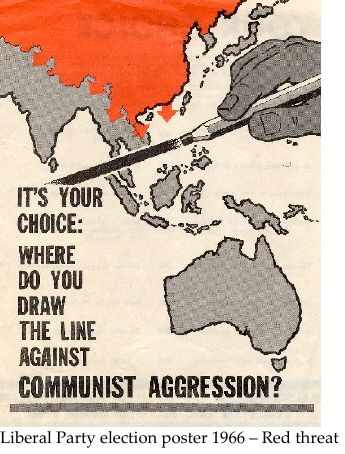
1971-79: Recognising Red Bandits
1971, 15 July. U.S. President Nixon announces that he will visit Beijing before
April 1972. Coalition is knocked sideways. Prime minister McMahon appears more terrified of five D.L.P. senators than the Coalition claimed it had been of a million-strong Peoples Liberation Army thrusting between the Pacific and Indian oceans, which had been its big lie during the 1966 khaki election.
25 October. The Peoples Republic is admitted to the United Nations and replaces the Republic of China on the Security Council.
1972, 21 February. U.S. passes formal control of Okinawa (the Ryukyu Islands) to Japan but keeps its bases there as forward stations against the PRC and Korea.
21-22 December. Whitlam administration recognises the PRC, withdrawing its envoy from Taiwan.
1979, 1 January. U.S. of A. breaks off diplomatic relations with Taiwan when recognizing the Peoples Republic of China. U.S. maintains relations via the America Institute in Taiwan but continues to supply the ROC with armaments and by granting special trading status.
1980, October. Taiwan’s Co-ordination Council or North American Affairs is accorded diplomatic status.
1987 to 1997: La guerre est fini
1987, July. Martial Law lifted in Taiwan.
1989, January. Ban on opposition parties lifted.
1991-92. End of one-party state under the KMT.
1991, April. The KMT regime gives up its claim to be the government of all of China, ending its state of war with the ‘Red Bandits’ in Beijing. The announcement carries a domestic embarrassment for 122 fossils in the Legislature, who had been ‘elected’ in 1948 to represent places they had not seen since, and who go on declaring themselves to be still in charge of all of China.
1998. The U.S. accepts the ‘three no’s policy’ towards Taiwan: ‘No’ to independence; ‘No’ to ‘two Chinas’; and ‘No’ to Taiwan’s membership of any international organisation with statehood as a precondition.
Appendix A: De-colonise the oceans!
As counsel for the Dutch East India Company during a conflict with the Portuguese in the Straits of Malacca, the theologian and poet, Hugo Grotius publishes Mare Liberum (‘The Free Sea’), since treated as the foundation for the law of the sea. The doctrine, which seems “so theoretical in the form … was of course eminently practical in its purpose enforced in the waters of the East Indies by the superior naval and military power” of the Dutch, and not by God or Natural Right, as Grotius implies.2 In that spirit, the rival imperialists came to accept a three-mile limit because it was further than a cannon ball could fly.
1930: Japan proposes that the sea between islands no more than 12 miles apart be considered territorial.
1945: The U.S.A. claims oil-drilling rights over its continental shelf no matter how far off shore, but refuses to knowledge Latin American claims to 200km. exclusive fishing zones.
1955-57. The Philippines and Indonesia assert ‘archipelagic statehood’ so that
all the waters between their 13,000 islands would be sovereign territory.3
1958: Geneva Convention codifies Mare Librium for those powerful enough to enforce it.
1973-4. United Nations Convention of the Law of the Sea III (UNCLOS III).
1982. U.N. Law of the Sea Convention concludes.
1992, February. PRC claims Spratlys, Paracel and Diaoyutasi Islands.
2011. 161 countries and all the members of the EU have signed on to the 1982 Convention. Taiwan cannot sign because it is not a member of the United Nations. The United States refuses to sign and so cannot be accused of failing to abide by its rulings.
2012. 10 September. Japanese government buys disputed islands from their Japanese owner in order to preserve their natural environment.
2013, 22 January. Philippines takes PRC to the Hague Tribunal over its occupation of Mischief Reef.
2016, 12 July. PRC refuses to accept ruling by Permanent Court of Arbitration in The Hague.
Rocky outcrops and reefs are not supposed to be concreted to keep them above high tide, as Japan has been doing since the 1960s.
Dividing the waters: Were the PRC to secure all the seas to which it lays claim, its Exclusive Economic Zone (EEZ) would come to a bit under 3m. sq. km. Meanwhile, the U.K. holds 6m. sq. km; France, 9.5m.; and the U.S. 12m. Indeed, Australia’s 2.6.m. sq. km. EEZ is almost as large as the total Chinese claims.
These numbers show the failure even to start on de-colonizing the oceans, as we see with Australia and the Timor Shelf on behalf of Woodside Petroleum, leading to the persecution of Witness K and his lawyer Bernard Collaery.
Appendix B: Cruising the waterfront
Of the forty-three Aircraft carriers in the world, the U.S. of A. has eleven nuclear-powered ones with a total deck space twice that of the other thirtytwo combined. Each U.S. carrier supports 80 aircraft, a total of 880.
1985. Chinese interests purchase the stripped-down H.M.A.S Melbourne for scrap before it passes to PLA Navy (PLAN) engineers to examine as the biggest vessel they have seen from the inside. China buys two stripped-down carriers from the erstwhile Soviet
States, the Minsk and the Kiev, one of which becomes a theme park and the other a luxury hotel.
1998. The PLAN buys a half-finished but stripped-down and engineless carrier from the Ukraine.
2012, Training and tests underway.
2016. Ready for service after eighteen years.
2019, December. The locally designed and constructed Liaoning class carrier enters service.
2017, February. Construction of a third carrier commences and is expected to be ready during 2023. Only then will the PLAN have a carrier group, which is perhaps one reason why the PRC is militarizing its off-shore islands against the Seventh Fleet with its Carrier Strike Groups.
2017, December. PLAN starts work on its first nuclear-power carrier.
U.S. Carrier Strike Groups (CSG) operate on the strategy of ‘Fight Tonight,’ which erases the distinction between strategy and tactics. China is accused of ‘destabilizing’ the South China Sea by ringing its shorelines, and some of its off-shore islands, with DF-21D and DF-26 missiles which have a respective range of 1300 miles and 2,400, are able to travel at six to twelve times het-speeds, and are designed to disable U.S. carriers – which are there purely to calm troubled waters.
The U.S. corporate-warfare state is scare-mongering to keep the cashflowing with alarums that the PRC now has the world’s largest Navy with 350 vessels against only 293 in the U.S.A.N. Those numbers tell us little about the throw weight of the respective forces. On that scale, the U.S.A.N. still rules the waves, even without the support from its suzerain states, Australia, Japan and South Korea.
Appendix C: The Chinese Century.
i. technology
Chinese technology is a mix of the highly advanced and the backward. They cannot make integrated circuits. They still do a lot of snapping-together of parts from East Asia. One suggestion is that Obama-Trump sanctions are driving them to come up with their own versions of more of the 300,000 widgets in your Apple i-phone. They are behind on quantum computing.
Rivals.
The Snowden Papers detail that U.S. concerns about Huawei is that its adoption anywhere would make it harder for the NSA to eavesdrop of the German cabinet and not because the Chinese could listen into the Oval Office. The National Security Agency has undertaken what it calls ‘supply chain enabling, exploitation, or intervention operations’, including ‘hardware implant enabling, exploitation or operations’.20 It intercepts shipments of computer network devices such as servers and routers, unseals them and installs beacon implants directly into these devices. It then repackages them and sends them along to the original destination. The NSA thus gains controlled backdoors in the ‘internet backbone’, providing potential access to an entire country’s core communication infrastructure. As Clinton Fernandes points out in the December 2020 Arena, Huawei-supplied infrastructure would interfere with the United States’ ability to keep spying at this
industrial-level scale—and would potentially allow China to do it as well. China tops all three categories in the OECD’s Programme for International Student Assessment based on scores drawn from only four of the wealthier urban areas while the raw data are a state secret. The results are as if Australia were judged only on selective schools while those in the bottom 20 per cent of Socio-Economic Scales did not exist.
ii. economy
Australians are in fear of China, yet again, but this time the panic is fueled by the prospects of economic dominance, which was far from the case in the second half of the nineteenth century which lead to the White Australia Policy, and in the 1950s and 1960s when it led to participating in democide (death by government) against the peoples of Indo-China.
A comparative case merits attention. Into the very early 1990s, the Japanese Superpower was going to dominate the global economy. The threat blew itself up during 1990 and has never recovered despite trillions of U.S. dollars in pump-priming, including, the government’s buying shares in corporates to keep up the Nikkei Index at around 20,000, or half of the peak in 1989.
Then there is the level of internal debts by banks, governments and state-run corporations. The volumes started to shoot up from the 1997-98 East Asia Financial Crisis but had not been wound back when China spent its way out of the 2008- implosion in the global expansion of capital, a move which did more to keep the Australian economy out of recession than did anything from Canberra.
For the last twenty years, there has been a consensus that Chinese statistics are a particularly boring form of science fiction. One consistent feature is the capacity of the real economy to come in at the official predictions – drawing the bullseye around the arrow.
Productivity increases have been at no more than the rate of labour’s being driven out of agriculture into other sectors. To get through these drag forces, the economy will need to depend on domestic demand as in the case of Japan and not the Belt-and Road.
Appendix D: Personal reflections
I can’t see Beijing doing more than continuing to issue threats – unless the Taiwan government declares independence. Their argy-bargy has been going on for seventy years and there are no grounds for its turning into open warfare without an about-turn in Taipei. The fact that so much Taiwanese capital is tied up in mainland undertakings is no certain ground for saying that neither side could afford a shooting war – remember that the leader of the German Socialists, Karl Kautsky, argued in 1914 that Super-Imperialism meant that a general European conflict could not break out.
One slow-burner to keep in sight is that all the KMT old guard have died replaced by at least three generations of Taiwanese who have their own view of themselves as overseas Chinese. Even those Taiwan-born who fear the CCP won’t want to be utterly divorced from being Chinese, unlike
Tibetans or the Uighurs. Of course, Beijing has done itself no favours on Taiwan by its treatment of Hong Kong, as shown by the swing in 2019 away from the KMT with its version of a ‘One-China’ future.
What we have are two variants of monopolising capitals, so that there is now one system, but two political cultures. That conjuncture raises the conceptual question of does the economy or the society define a ‘country’. Do Chinese now have two countries but one economic system?
Do Montgomery’s two rules for war still apply?: one, never march on Moscow; two, do not put a land army into China. Is the U.S. still a whale and China an elephant? If not, how will their forces engage?
War can take more forms than an invasion – which seems the least likely to prove successful for the PRC. Cyber warfare as the U.S. did in to derail Iran’s nuclear program with Stuxnet in 2009, and who will know where else – Venezuela’s power grids? – until the next Wikileaks or Snowden-style dump?
Envoi
What does this sudden uneasiness mean,
And this confusion? (How grave the faces have become!)
Why are the streets and squares rapidly emptying,
And why is everyone going back home so lost in thought?
Because it is night and the barbarians have not come.
And some men have arrived from the frontiers
And they say that barbarians don’t exist any longer.
And now, what will become of us without barbarians!
They were a kind of solution.
C.P. Cavafy, “Waiting for the Barbarians,” Collected Poems
(Princeton, NJ: Princeton University Press, 1992), 19.
1 Frederick Engels, The Condition of the Working Class in England (London: Penguin, 1987), 118.
2 Herbert H. Rowen (ed.), The Low Countries in Early Modern Times, (London: Macmillan,
1972), 150.
3 Humphrey McQueen, Japan to the Rescue, Australian Security Around the Indonesian
Archipelago During the American Century (South Melbourne: William Heinemann, 1991), 77-98.
On www.surplusvalue.org.au/mcqueen
Sources:
Clark, Greg, In Fear of China (Melbourne: Lansdowne, 1967).
Cheney, Amanda J., “Tibet, Lost in Translation. Sovereignty, Suzerainty, and
International Order Transformation, 1904-06,” Journal of Contemporary China,
26, no. 107 (2017): 769-83.
Goddard, W.G., Formosa: A study in Chinese History (London: Macmillan,
1966), informative until the final chapter which is an apology for the
Generalissimo.
Gott, K.D., Formosa Danger Spot for Peace (Melbourne: Peace Council, 1953).
Mackerras, Colin, Modern China, A Chronology (London: Thames & Hudson,
1982).
McQueen, Humphrey, Japan to the Rescue, Australian Security Around he
Indonesian Archipelago During the American Century (South Melbourne: William
Heinemann, 1991), 77-98. www.surplusvalue.org.au/mcqueen
Maxwell, Neville, India’s China War (Harmondsworth: Penguin, 1970).
Nolan, Peter, “Imperial Archipelagos China, Western Colonialism and the
Law of the Sea,” New Left Review, 80 (2013).
O’Brien, Conor Cruise, To Katanga and back (London: Hutchinson, 1962).
Williams, Neville, Chronology of the Modern World 1763-1965 (Harmondsworth:
Penguin, 1975).
The Statesman’s Year Book (London: Macmillan.)
Clinton Fernandes Trump’s war on Huawei about control of global computer-chip industry

